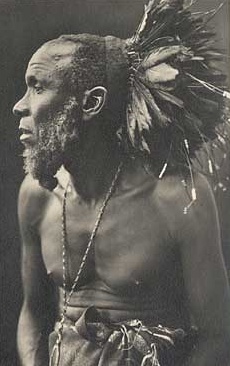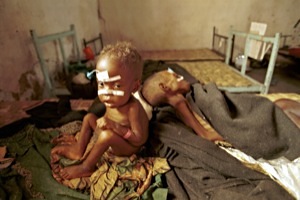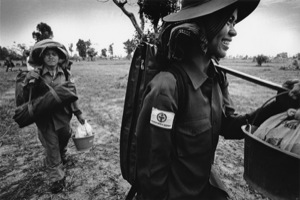Imaging ‘Others’
By Caitlin Patrick
Photography as a technology and practice was developed in an age of Western European cultural, economic and political expansion. How early photographers from Europe and North America represented the new places they encountered is thus intimately bound up with their nation-states’ foreign and domestic politics and colonial practices. Many of these early photographic styles and approaches have had lasting impacts to present times. Most photography involves an interaction with something or someone else, an ‘other’, and understanding how this self/other boundary functions and fluctuates is a key element of photographic study. Identity creation has consistently revolved around the factors of race, class and gender, and these are important factors for understanding how photographic practices interact with processes of identity formation.
James Ryan’s work on visual elements of colonial geographic practice provides ways of understanding how ‘Western’ knowledge and cultural attitudes towards ‘the rest’ of the world were historically developed. Ryan investigates how cameras were immediately enlisted in projects of empire-building, whether they were being brought to record battle scenes, to preserve images of landscapes and topography, or to allow the flora, fauna and peoples of the colonies to be classified and displayed in centres of colonial power.
Photography was seen, like other Western sciences and technologies, both as proof of Western intellectual and cultural superiority to ‘other’ areas but also as means by which these places could be absorbed into Western knowledge and control. Used in conjunction with telescopes and microscopes, photography also expanded human powers of observation and observable space. Inevitably, these new spaces were invested with meaning that was not simply based on obvious, visual ‘facts’ of the photographs, as many might have liked to believe, but were also tied to the fantasies and imaginings about other worlds beyond the immediate experiences of their creators and viewers.

Casimir Zagourski (1883-1944)
Teke Chief, Belgian Congo
L’Afrique qui disparait! Series 1, no. 3
c. 1929-37, silver gelatin print on postcard stock
Eliot Elisofon Photographic Archives
National Museum of African Art, Smithsonian Institution
Ryan points out that it was not just the 'dark' and 'unknown' regions of the expanding colonies that were exposed to the 'light' of cameras. The 'deviant', different and marginal populations of the Western world itself were also explored and compared. Thus, during the Victorian and Edwardian eras, the East End of London became imaged and described as a place of darkness, danger, illness and the unknown using some of the same vocabulary and photographic techniques as were being used to document distant colonial topographies.
Using the theoretical insights of Michel Foucault, an influential scholar for those studying colonial and postcolonial practices, forms of colonialism are commonly understood to entail both dominating forms of power, in a variety of types of overt exploitation and control, and more 'productive' forms, such as attempts at 'education' of colonial subjects in order to help them achieve Western norms and standards of efficiency, technology and development. All these terms, and indeed the entire discourse of 'development', are loaded with particular meanings of what it is to be 'civilized' or 'primitive' human beings in the nineteenth, twentieth and twenty-first centuries. These understandings have had a major impact on how various groups of people were and are photographed.
Edward Said's work is significant for its efforts at describing the history and mindset of colonialism as well as media perpetuation of colonial ideas. Influenced by Foucault, Said argues that a complex set of representations was historically created, developing a structure for how 'the West' would understand and interact with 'the Orient'. This imaginary framework largely determined Western involvement with the vast and diverse regions subsumed under the term 'Orient', 'Third World' or 'developing world' from colonial days to present. Said's hope is that realization of this situation will lead to efforts to develop different ways of understanding and imaging 'others', ways which do not postulate the existence of a single set of characteristics representing the 'other' or 'the Orient' where, in fact, he sees diverse and ungeneralizable groups.

J.B Russell/Panos
Severely malnourished children at a Medecins Sans Frontieres (MSF) therapeutic feeding centre in Angola. Aid organizations have had access to large portions of the country only after a ceasefire was signed in April 2002.
Difficulties for this position arise, according to Robert Young, when Said attempts to posit a critical place for intellectuals distanced from contemporary ideologies. In Young's opinion, this retention of the Western humanist conception of the critical individual prevents Said from exploring how 'the West's' creation of the 'Third World' or 'the Orient' reflects its own self-doubts and internal contradictions rather than misrepresenting 'real' aspects of these places. Young, taking a perspective indebted to the theory of Jacques Derrida, suggests that this position traps Said in having to say that there is a 'right' or 'wrong' way to interpret these discursive categories, which Young believes should not be treated as fixed or stable. Other theorists, engaging with issues of (post)colonialism after the publication of Said's Orientalism, have developed many of his ideas while attempting to steer clear of his dilemmas. They argue that colonial stereotypes are not crude or 'incorrect' but rather are complex, ambivalent and contradictory. Homi Bhabha has developed the idea of the 'colonial mimic': hybrid, fetishized identities practiced by colonized peoples that both adopt some features of the colonizer but which also, precisely because of these adoptions, can become threatening to the colonizer.

Sean Sutton-MAG/Panos
Deminers from the Church World Service (CWS) carry equipment on their way to work in the Svay Kdor minefield. The CWS assists the Mines Advisory Group (MAG) in the clearance of unexploded ordnance (UXO) in Cambodia.
Photography and practices of representing ‘others’ are thus often seen as unstable, fluid and shifting - like the colonial project itself. Despite giving ample proof of the endurance of particular colonial discourses, human geographer Derek Gregory nonetheless recognizes, in line with the thought of Judith Butler, Young and Bhabha, that “every repertory performance of the colonial present carries within it the twin possibilities of either reaffirming and even radicalizing the hold of the colonial past on the present or undoing its enclosures and approaching closer to the horizon of the post colonial.” (Gregory, 2004: 19) The power of photography thus resides in its ability to challenge established ways of understanding people and places, as well as to consolidate existing or predominant beliefs.
These theoretical shifts in understanding identity production have been accompanied by important practical and technological changes, which have allowed greater numbers of citizens from the ‘developing world’ to present their lives to others through their own lens of perspective. The growth of both traditional media industries in these areas, as well as new Internet-based options, offer possibilities to encourage these developments and make photographs and stories produced by majority world citizens more widely available on a global basis.


